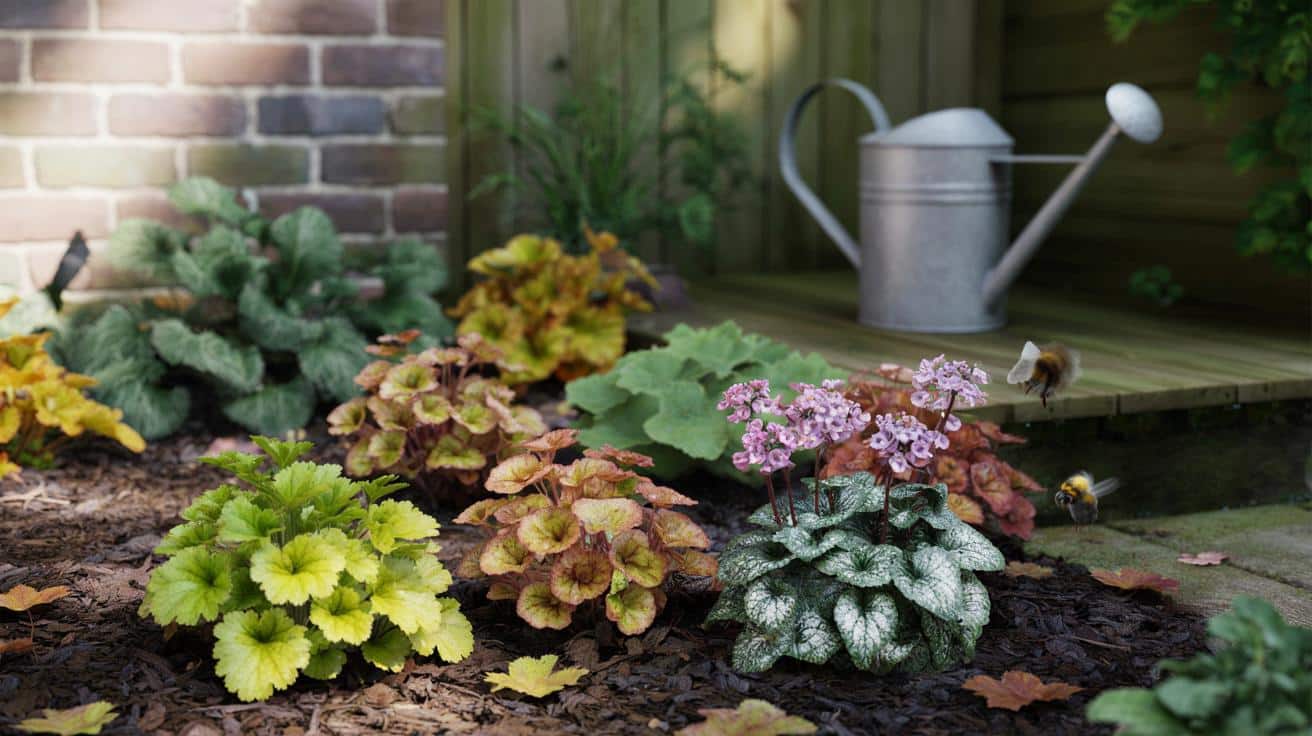Across Britain, time-poor gardeners are turning to a quiet fix: hardy perennials that settle in now and cut chores for years. November’s cool rain and warm soil make planting simple. Beds knit together by spring, borders look fuller, and the watering can stays parked.
The low-care trio gaining ground
Three stalwarts keep cropping up in conversations at allotments and balcony pots alike: heucheras, epimediums and pulmonarias. Each thrives in shade or dappled light, holds its own through dry spells, and turns bare corners into soft, textured planting.
Heucheras: colour without faff
Heucheras act like living carpets. Leaves range from lime and amber to deep claret. Plants keep their shape in winter, so beds never look empty. They suit pots, edges and underplanting around small trees. A single variety gives calm. A mix of tones gives drama.
Epimediums: quiet spreaders with staying power
Often called barrenwort, epimediums excel where grass sulks. They thread through poor soil, shrug off dry shade and form a tight mat. Spring brings airy flowers. Foliage shifts tone through the year, giving movement without constant care.
Pulmonarias: early flowers and speckled leaves
Pulmonarias wake early. Clusters open in pinks, purples and blues while frost still nips. Silver-flecked leaves brighten dark beds. They partner shrubs, fill gaps under hedges and hold moisture under mulch. Bees turn up at the first bloom.
Plant in November, water once to settle, then let rain and roots do the heavy lifting until spring.
Why autumn planting pays
Rooting while you rest
Soil stays above 7°C in many regions through late autumn. Roots establish without top growth. Plants face less stress than in spring. You water on day one, then nature takes the shift.
Spacing and structure that lasts
Set plants 30–40 cm apart. Use triangles to close gaps fast. Place heucheras at the front for colour, epimediums through the middle for cover, pulmonarias in pockets that catch spring light. Repeat the pattern to lead the eye.
Mulch and minimal feeding
Lay 5–7 cm of leafmould or chipped prunings after planting. Mulch locks in moisture and feeds the soil life. Add a handful of compost per plant. Skip strong fertiliser. You want roots to search and knit.
How these plants cut your chores
Drought resilience built in
Once established, the trio tolerates dry spells that parch lawn. Deepening roots tap moisture. Thick leaves lose less water. You water only in the first spring dry week if soil dusts over.
Shade tolerance that actually works
This group shines where fences, sheds and townhouses block light. They colonise the awkward north side. They soften the base of conifers. They make use of soil you thought was a write-off.
Weed suppression without chemicals
Dense crowns and overlapping leaves smother bare soil. Fewer light gaps mean fewer germinating weeds. You hand-pull stragglers once in early spring and move on.
Thick cover, less evaporation, fewer weeds: one planting round can halve routine bed maintenance next year.
At-a-glance performance
| Plant | Light | Soil | Height/spread | Peak moment |
|---|---|---|---|---|
| Heuchera | Shade to part sun | Well-drained, humus rich | 30–45 cm / 35–50 cm | Foliage colour all year |
| Epimedium | Shade to dappled | Dry shade tolerant | 25–40 cm / 40–60 cm | Spring flowers, shifting leaves |
| Pulmonaria | Shade to dappled | Moist, not waterlogged | 25–35 cm / 40–60 cm | Late winter to early spring bloom |
A simple plan you can action this weekend
- Map 3–5 patches in shade where grass fails or pots underperform.
- Buy 9–12 plants per 2 m² mix (1-litre pots at £6–£12 each).
- Weed once, fork lightly, add two litres of compost per hole.
- Plant on a 35 cm grid, water in, then mulch to a mug’s depth.
- Leave until March, then trim any tatty leaves and top up mulch.
The numbers that change your weekends
Watering mixed borders in summer often eats 20–30 minutes, two nights a week, across 10 warm weeks. That’s 400–600 minutes, or 6.5–10 hours. Add fortnightly weeding and you can burn another 45–60 minutes per bed across the season. Groundcover reduces that time sharply.
Run the sums for a small urban plot. Replace two thirsty strips of bedding with this trio. You might skip 8 of 10 summer watering runs and halve weeding time next year. That is about 62 hours across a season in many homes, plus less tap water and fewer impulse buys at the garden centre.
One mixed border of 12 plants can save roughly £30–£60 in water and sundries in a single season.
Smart combinations that keep interest high
Colour echoes and textures
Pair lime heuchera with silver-leaf pulmonaria to brighten dark corners. Use amber heuchera near brick for warmth. Thread epimedium through fern clumps for contrast and steady cover. Repeat colours in pots to tie the scene to the patio.
Positioning that helps wildlife
Let pulmonaria catch late winter sun under deciduous shrubs; bees will find it fast. Keep a shallow tray of water near these beds for hoverflies and birds. Avoid pesticides near heucheras, which can shelter beneficial insects at the crown.
Common pitfalls and how to dodge them
Vine weevil larvae can nibble heuchera roots in containers. Check for notched leaves in summer and use biological controls in late summer if needed. Pulmonaria sags in hot, open positions; give mulch and light shade. Cut back tired epimedium leaves in late winter so new flowers show cleanly.
If you only have a balcony
Use a wide trough with drainage holes. Mix two heucheras, one pulmonaria and a small evergreen like euonymus. Add a 3 cm mulch of fine bark. Water deeply, then let the planter almost dry before the next soak. Rotate the trough a quarter turn each month to even light.
Extra notes for planners
Aim for coverage within 12–18 months. Budget £70–£130 for a 2 m² starter bed, including mulch. In sandy soils, add more compost at planting. In heavy clay, raise the bed 5–8 cm and plant slightly proud to prevent waterlogging. Rejuvenate clumps every four years by lifting and dividing the outer growth in early spring.
Want a trial run first? Plant three of each in a single 1 m² test patch. Track watering time and weed counts with your phone. Compare with an adjacent area. If the numbers look good by August, scale up in autumn. This small experiment keeps risk low and proves the value in your own garden, not just on the label.








